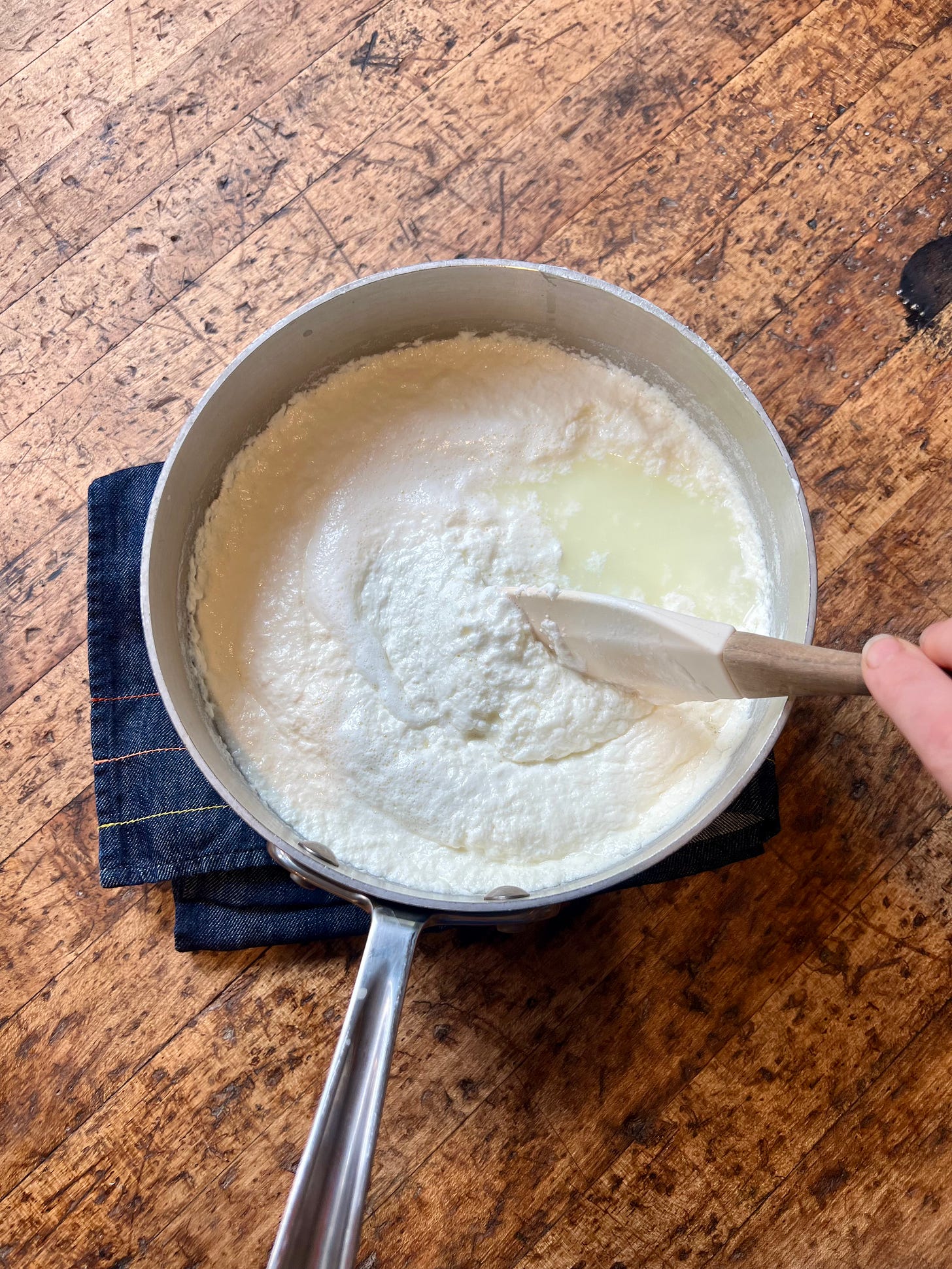The Joys of Homemade Ricotta
In which we make ricotta on the stovetop, I (hopefully) convince you that ricotta is worth putting in the *make, not buy* category, and we use said ricotta for two delightfully summer-y recipes.
Making ricotta at home might seem unnecessary; however, the quality and texture of what you can produce on your stovetop far surpasses what’s usually available in grocery stores. It’s also cheaper.
This process has the additional benefit of being a bit science-y. There’s a special feeling that goes along with this kind of transformation, a little boost of glee you’ll get from watching liquid to turn to solid, and milk, cream, and buttermilk change into to curds and whey.
Homemade ricotta is the kind of thing that you can get very used to just having around. It’s gorgeous on pizza, or in a tomato sandwich. It can be tossed with pasta, fresh herbs and a little pasta water for a quick creamy sauce, and it pairs exceptionally well with all of the things that you might have in abundance in your garden right now.
This month we’re putting our homemade ricotta to use in two of my favorite recipes: a delicious & versatile Almond-Ricotta Cake with Summer Fruit, and a Green Bean & Cherry Tomato Salad with Toasted Pistachio Oil & Ricotta.
Yield: just under one pint
Ingredients
4 cups whole milk
1 cup heavy cream
1 ¼ cups buttermilk (whole milk, not lowfat, preferred)
1 teaspoon kosher salt
Combine all of the ingredients in a heavy-bottomed saucepan. (At home, I use a 3-qt sized pan.) Place on medium-high heat.
As the mixture heats, use a spatula to gently scrape the bottom of the pan every couple of minutes to prevent any sticking.
When the mixture starts to approach a boil, you should see curds starting to form. Now is the time to stay focused. As the mixture starts to rise around the edges, count for 5-10 seconds, then remove the pan from the heat just before it starts to actually turn over and boil.
Let the mixture rest for 10-15 minutes. The ricotta should separate and float on the top (as pictured above).
Set up a fine mesh strainer over a large bowl or container. Using a slotted spoon, gently lift the solid curds out of whey, and lay them into the strainer. (You’ll be able to collect the majority of the ricotta this way; we’ll strain the rest of the ricotta out of the whey next.) Let the ricotta drain for about 15 minutes, until most of the liquid come out, but before the curds get too dry. Transfer the ricotta to a container for storage and set the strainer back over the bowl.
Pour the remaining whey through the emptied strainer and collect any remaining ricotta. You may also find some ricotta sticking to the pan, which you can gently scrape off with a spatula. Let this additional ricotta drain, then add it to your previously strained batch.
Store the ricotta in an airtight container; it can be kept in the fridge for up to a week.
Notes on this recipe
Resist the urge to cook the ricotta any longer than outlined above. I know that it can be tempting to cook it longer to “make sure” that the curds are set, but that strategy will backfire. Continuing to cook the mixture once the curds have formed can make the curds rubbery and will rob the cheese of its lovely creaminess.
The only stirring needed is the incidental mixing that occurs as you gently scrape the bottom of the pan to prevent sticking. Additional or more vigorous mixing is not needed, and I’ve found that it can actually interrupt the formation of nice curds.
As a non-pig owner, I (regretfully) don’t have any obvious uses for whey. I did dilute a recent batch of whey and pour it on my tomato plants and my blueberry bushes. But results are TBD. If you have any clever suggestions for using whey, they would be more than welcome in the comments section.


This month's ricotta recipes





Thank you. I used to make ricotta and remember it being amazing compared to commercial but lost the recipe packet. Do you think it would work with lactose free milk and heavy cream (buttermilk is already virtually lactose free)? I can’t digest lactose and no one seems to make lactose free ricotta that is not non-dairy. I’m reluctant to use non dairy replacement products as they seem to be full of chemicals and family members are allergic to vegetable gum and other stabilizers.